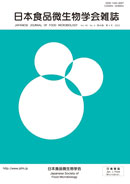
- 4 号 p. 103-
- 3 号 p. 81-
- 2 号 p. 57-
- 1 号 p. 1-
- |<
- <
- 1
- >
- >|
-
宮本 敬久2023 年40 巻4 号 p. 103-112
発行日: 2023/12/30
公開日: 2024/01/12
ジャーナル フリーPDF形式でダウンロード (1372K)
-
水野 卓也, 野田 万希子, 小池 紀子, 桐井 久美子, 山口 智博, 亀山 芳彦2023 年40 巻4 号 p. 113-121
発行日: 2023/12/30
公開日: 2024/01/12
ジャーナル フリーThis study aimed to determine the cause of growth inhibition of diarrheagenic Escherichia coli (DEC) in modified EC (mEC) broth containing other bacteria. The growth of DEC in mEC broth with non-DEC bacteria was evaluated by lactose fermentation, growth rate, and the ratio of DEC to non-DEC bacteria before enrichment culturing. The results showed that non-lactose fermenting bacteria did not compete with DEC because lactose contributes considerably to the growth of bacteria in mEC broth. In the mEC broth, all the bacteria stopped growing after the total number of bacteria reached approximately 9.0 log CFU/mL, primarily because of lactose depletion. Moreover, the growth of DEC in mEC broth with coliform bacteria depends on the ratio of DEC to coliform bacteria in the specimen and the growth rate of coliform bacteria. However, DEC isolation cannot exclude the influence of non-pathogenic E. coli in the specimen because most DEC possess drug susceptibility and biochemical characteristics similar to non-pathogenic E. coli. Estimation of the DEC population in mEC broth after enrichment culturing by quantitative PCR is useful to predict the result of DEC isolation. Moreover, the use of isolation media other than those identified by lactose fermentation can improve the detection rate of DEC.
抄録全体を表示PDF形式でダウンロード (619K) -
榊田 希, 高瀬 冴子, 山﨑 悠華, 貫洞 里美, 鹿島 かおり, 島田 慎一, 石井 里枝2023 年40 巻4 号 p. 122-128
発行日: 2023/12/30
公開日: 2024/01/12
ジャーナル フリーThe definition of EASTEC refers to Escherichia coli strains lacking any well-established diarrheagenic factors except for the enteroaggregative E. coli (EAggEC) heat-stable toxin 1 gene (astA). However, the causative food source has often remained unidentified in these outbreaks, possibly due to the lack of appropriate detection methods for EASTEC in food products. To address this issue, we conducted a study comparing different strains of EASTEC O166:H15, the most common serotype, with varying origins, and investigated the usefulness of various culture and screening methods, including real-time PCR. We found that the growth of all tested strains was suppressed on agar containing cefixime-tellurite supplement or 2 mg/L tobramycin, but not on agar with 1 mg/L tobramycin. In the additive recovery test, CHROMagar STEC with 1 mg/L tobramycin and SMAC with 1 mg/L tobramycin showed relatively high detection rates. Furthermore, real-time PCR of the inoculum showed a detection sensitivity of 1.00 (20/20) under all enrichment culture conditions, with Ct values around 20. Based on our results, we conclude that a combination of the culture method using tobramycin-added selective agars and screening by real-time PCR may be an efficient and effective method for detecting EASTEC in food products.
抄録全体を表示PDF形式でダウンロード (407K)
- |<
- <
- 1
- >
- >|